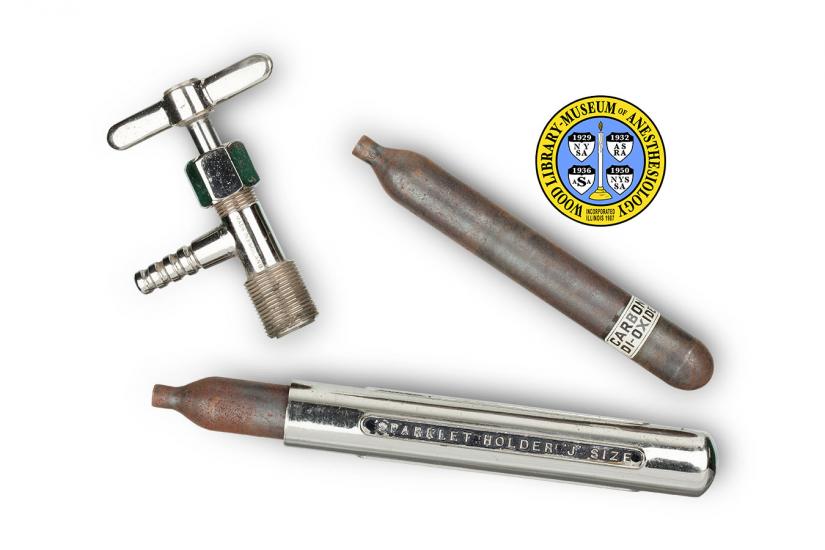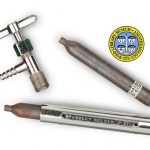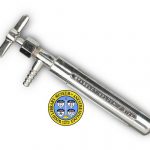Sparklet Apparatus
The Sparklet Apparatus was introduced in 1927 by British physician H. Whitridge Davies to hasten the inhalation of ether during anesthesia and for the treatment of respiratory failure. It was made by Sparklets, Limited, of London from the 1920s through the 1950s. These devices were marketed to doctors, patients, and public service departments. The Sparklet could be used with a compressed gas cylinder of oxygen (O2), carbon dioxide (CO2), or a mixture of the two. Both gases were recommended for inhalation therapy in cases of asthma, whooping cough, and pneumonia. Squeezing the lever would puncture the cylinder, releasing the gas at a predetermined rate. Some forms of the apparatus delivered the gas through a rubber tube, bag, and mask.
This was also used as a resuscitation device, delivering carbon dioxide for cases of asphyxiation, drug overdose, shock, and drowning. In the 1950s, greater understanding of respiratory physiology made this use of CO2 obsolete. The same apparatus could also be adapted to apply CO2 as a topical, refrigerant anesthetic, called "carbon dioxide snow". Like ethyl chloride, CO2 evaporates very quickly so that when it is sprayed onto the body it produces very cold temperatures that temporarily numb the skin.
Catalog Record: Sparklet Apparatus
Three Catalog Records (akwv, akww, akwx)
Access Key: akwv
Accession No.: 2012-03-07-1 A
Title: Sparklet holder : ‘J’ size.
Corporate Author: Sparklets Ltd.
Title variation: Alt Title
Title: Sparklet apparatus.
Title variation: Alt Title
Title: Holder from a Sparklet resuscitator.
Title variation: Alt Title
Title: Sparklet resuscitator holder, model J.
Title variation: Alt Title
Title: Sparklet carbon dioxide resuscitator.
Publisher: [London] : [Sparklets Ltd.], [between 1927 and 1960].
Physical Descript: 1 resuscitation apparatus : metal ; 23.5 x 7.5 x 6 cm.
Subject: Resuscitation – instrumentation.
Subject: Resuscitation – history.
Subject: Respiration, Artificial – instrumentation.
Subject: Carbon Dioxide.
Note Type: General
Notes: The early year in the date range for the possible year of manufacture is
based on the first publication found about the Sparklet Resuscitator (Davies,
1927). The end date is based on two articles. One about the Sparklet
Resuscitator written by M. Wrigley and P. Nandi (1993). The other about the
use of carbon dioxide in resuscitation written by D. Fahey (2010-2011). The
date range could change if new documentation indicates that it should be
corrected.
Note Type: General
Notes: Title taken from the holder itself.
Note Type: Citation
Notes: Davies HW. A simple portable apparatus for the therapeutic administration of
carbon dioxide. Br J Anaesth. 1927;4(3):148-153.
Note Type: Citation
Notes: Fahey D. The use of carbon dioxide in resuscitation. St. John Hist.
2010-2011;10:12-17. https://stjohn.org.
au/assets/uploads/history%20journal/History_vol_10.pdf. Accessed August 17,
2014.
Note Type: Citation
Notes: Wrigley M, Nandi P. The Sparklet carbon dioxide Resuscitator. Anaesthia.
February, 1993;49(2):148-150. [Confirm that it is volume 49 and not 48]
[Get?: Leigh JM. Ideas and anomalies in the evolution of modern oxygen
therapy. Anaesthesia. 1974;29:335-348.][Get?: Merriman J. The role of carbon
dioxide in anaesthesia. Can Anaes Soc J. 1955;2:273-280.]
Note Type: Physical Description
Notes: One holder for a Sparklet Resuscitator; The approximate height of the holder
with the top in place is 23.5 cm; The width was based on the turn key
(approximately 7.4 cm; The depth was based on the tip of the nozzle to the
back of the holder (approximately 6 cm); The holder is marked with the
following embossed text, “SPARKLET HOLDER ‘J’ SIZE”.
Note Type: Reproduction
Notes: Photographed by Mr. Steve Donisch, September 18, 2013, with two small CO2
cylinders from accession number 2006-06-10-1 (SydneyPlus library keys akww
and akwx).
Note Type: Historical
Notes: Described here is a ‘holder’ for small carbon dioxide (CO2) cylinders used in
the “Sparklet Resuscitator,” model J. It was introduced in 1927 by British
physician H. Whitridge Davies to hasten the inhalation of ether during
anesthesia and for the treatment of respiratory failure.
During the 1920s and 1930s, the relatively new understanding of CO2’s ability
to stimulate the rate and depth of respiration began to be applied to the
treatment of people who were not breathing. The administration of carbon
dioxide with air or oxygen to people who had drowned or were in respiratory
failure for variety of reasons (including drug overdose, carbon monoxide
poisoning, and shock) continued into the 1950s. This was when our
understanding of respiratory physiology began to blossom and the use of CO2
for resuscitation was soon abandoned.
The Sparklet Resuscitator was manufactured by Sparklets Ltd., a company that
specialized in making equipment that could dispense carbonated water.
Sparklets Ltd. produced two models of Sparklet Resuscitators named for the
size of the CO2 cylinder used: the”C” and the “J”. A cylinder was placed in
the resuscitator’s “holder.” Then the handle was screwed down to puncture the
cylinder and allow a flow of 1 to 2 liters of CO2 per minute for
approximately six minutes. Rubber tubing was connected to the nozzle of the
holder so that the gas could be directed to a mask over the patient’s mouth,
or, in more complicated arrangements, to a reservoir bag.
Note Type: Publication
Notes: Dalton H. The Sparklet Resuscitator as an aid to artificial respiration: the
development of its uses in the Metropolitan Police Force and the results
obtained. Police J. 1938;11:172.
Note Type: Publication
Notes: Raphael G. Sparklet Resuscitator as an aid to artificial respiration. Police
J. 1935;8:150.
Note Type: Exhibition
Notes: Selected for the WLM website.
Access Key: akww
Accession No.: 2006-06-10-1
Title: Carbon di-oxide [“J” size sparklet bulb].
Corporate Author: Sparklets Ltd.
Title variation: Alt Title
Title: J Sparklet bulb for carbon di-oxide.
Title variation: Alt Title
Title: Carbon di-oxide “J” size sparklet ampule.
Title variation: Alt Title
Title: J cylinder for a Sparklet apparatus.
Title variation: Alt Title
Title: Ampule for a Sparklet resuscitator, model J.
Title variation: Alt Title
Title: J size ampule for a Sparklet resuscitator.
Publisher: [London] :[Sparklets Ltd.], [between 1927 and 1960].
Physical Descript: 1 cylinder : iron, other metals ; 16.5 cm in length x 2.5 cm in diameter.
Subject: Cardiopulmonary Resuscitation – instrumentation.
Subject: Carbon Dioxide.
Subject: Respiration, Artificial – instrumentation.
Note Type: General
Notes: The early year in the date range for the possible year of manufacture is
based on the first publication found about the Sparklet Resuscitator (Davies,
1927). The end date is based on two articles. One about the Sparklet
Resuscitator written by M. Wrigley and P. Nandi (1993). The other about the
use of carbon dioxide in resuscitation written by D. Fahey (2010-2011). The
date range could change if new documentation indicates that it should be
corrected.
Note Type: General
Notes: Regarding the sources for the title: “Carbon di-oxide” was taken from the
markings on the bulb (ampule) itself. ‘”J” size sparklet bulb’ was taken from
the instruction sheet that is pasted to the inside lid of the box for “The
Sparklet Resuscitator” from which it came. An alternate title came from the
label on the cardboard box from which it was taken. This cardboard box sits
in the box for the entire resuscitator.
Note Type: With
Notes: Part of a Sparklets Resuscitator case (SN-000287).
Note Type: Citation
Notes: Davies HW. A simple portable apparatus for the therapeutic administration of
carbon dioxide. Br J Anaesth. 1927;4(3):148-153.
Note Type: Citation
Notes: Fahey D. The use of carbon dioxide in resuscitation. St. John Hist.
2010-2011;10:12-17. https://stjohn.org.
au/assets/uploads/history%20journal/History_vol_10.pdf. Accessed August 17,
2014.
Note Type: Citation
Notes: Wrigley M, Nandi P. The Sparklet carbon dioxide Resuscitator. Anaesthia.
February, 1993;49(2):148-150. [Confirm that it is volume 49 and not 48]
[Get?: Leigh JM. Ideas and anomalies in the evolution of modern oxygen
therapy. Anaesthesia. 1974;29:335-348.][Get?: Merriman J. The role of carbon
dioxide in anaesthesia. Can Anaes Soc J. 1955;2:273-280.]
Note Type: Physical Description
Notes: One metal (iron and other metals) ampule (or bulb) for storing and
administering carbon dioxide; It measures approximately 16.2 cm in length and
2.2 cm in diameter; A white label with black lettering is marked, “CARBON
[new line] DI-OXIDE”; the black paint of the ampule is worn off and there is
much rusting of the exterior of the ampule.
Note Type: Reproduction
Notes: Photographed by Mr. Steve Donisch, September 18, 2013, with a Sparklet
Resuscitator holder (accession number 2012-03-07-1 A) and a second CO2 ampule
This is the bulb that was photographed inside the Sparklet holder.
Note Type: Historical
Notes: Described here is a small carbon dioxide (CO2) cylinder used in the “Sparklet
Resuscitator,” model J. It was introduced in 1927 by British physician H.
Whitridge Davies to hasten the inhalation of ether during anesthesia and for
the treatment of respiratory failure.
During the 1920s and 1930s, the relatively new understanding of CO2’s ability
to stimulate the rate and depth of respiration began to be applied to the
treatment of people who were not breathing. The administration of carbon
dioxide with air or oxygen to people who had drowned or were in respiratory
failure for variety of reasons (including drug overdose, carbon monoxide
poisoning, and shock) continued into the 1950s. This was when our
understanding of respiratory physiology began to blossom and the use of CO2
for resuscitation was soon abandoned.
The Sparklet Resuscitator was manufactured by Sparklets Ltd., a company that
specialized in making equipment that could dispense carbonated water.
Sparklets Ltd. produced two models of Sparklet Resuscitators named for the
size of the CO2 cylinder used: the”C” and the “J”. A cylinder was placed in
the resuscitator’s “holder.” Then the handle was screwed down to puncture the
cylinder and allow a flow of 1 to 2 liters of CO2 per minute for
approximately six minutes. Rubber tubing was connected to the nozzle of the
holder so that the gas could be directed to a mask over the patient’s mouth,
or, in more complicated arrangements, to a reservoir bag.
Note Type: Exhibition
Notes: Selected for the WLM website.
Access Key: akwx
Accession No.: 2006-06-10-1
Title: Carbon di-oxide [“J” size sparklet bulb].
Corporate Author: Sparklets Ltd.
Title variation: Alt Title
Title: Carbon di-oxide “J” size sparklet ampule.
Title variation: Alt Title
Title: J Sparklet bulb for carbon di-oxide.
Title variation: Alt Title
Title: J cylinder for a Sparklet apparatus.
Title variation: Alt Title
Title: Ampule for a Sparklet resuscitator, model J.
Title variation: Alt Title
Title: J size ampule for a Sparklet resuscitator.
Publisher: [London] :[Sparklets Ltd.], [between 1927 and 1960].
Physical Descript: 1 cylinder : iron, other metals ; 16.5 cm in length x 2.5 cm in diameter.
Subject: Cardiopulmonary Resuscitation – instrumentation.
Subject: Respiration, Artificial – instrumentation.
Subject: Carbon Dioxide.
Note Type: General
Notes: The early year in the date range for the possible year of manufacture is
based on the first publication found about the Sparklet Resuscitator (Davies,
1927). The end date is based on two articles. One about the Sparklet
Resuscitator written by M. Wrigley and P. Nandi (1993). The other about the
use of carbon dioxide in resuscitation written by D. Fahey (2010-2011). The
date range could change if new documentation indicates that it should be
corrected.
Note Type: General
Notes: Regarding the sources for the title: “Carbon di-oxide” was taken from the
markings on the bulb (ampule) itself. ‘”J” size sparklet bulb’ was taken from
the instruction sheet that is pasted to the inside lid of the box for “The
Sparklet Resuscitator” from which it came. An alternate title came from the
label on the cardboard box from which it was taken. This cardboard box sits
in the box for the entire resuscitator.
Note Type: With
Notes: Part of a Sparklets Resuscitator case (SN-000287).
Note Type: Citation
Notes: Davies HW. A simple portable apparatus for the therapeutic administration of
carbon dioxide. Br J Anaesth. 1927;4(3):148-153.
Note Type: Citation
Notes: Fahey D. The use of carbon dioxide in resuscitation. St. John Hist.
2010-2011;10:12-17. https://stjohn.org.
au/assets/uploads/history%20journal/History_vol_10.pdf. Accessed August 17,
2014.
Note Type: Citation
Notes: Wrigley M, Nandi P. The Sparklet carbon dioxide Resuscitator. Anaesthia.
February, 1993;49(2):148-150. [Confirm that it is volume 49 and not 48]
[Get?: Leigh JM. Ideas and anomalies in the evolution of modern oxygen
therapy. Anaesthesia. 1974;29:335-348.][Get?: Merriman J. The role of carbon
dioxide in anaesthesia. Can Anaes Soc J. 1955;2:273-280.]
Note Type: Physical Description
Notes: One metal (iron and other metals) ampule (or bulb) for storing and
administering carbon dioxide; It measures approximately 16.2 cm in length and
2.2 cm in diameter; A white label with black lettering is marked, “CARBON
[new line] DI-OXIDE”; the black paint of the ampule is worn off and there is
much rusting of the exterior of the ampule.
Note Type: Reproduction
Notes: Photographed by Mr. Steve Donisch, September 18, 2013, with a Sparklet
Resuscitator holder (accession number 2012-03-07-1 A) and a second CO2 ampule
This is the bulb that was photographed next to the Sparklet holder.
Note Type: Historical
Notes: Described here is a small carbon dioxide (CO2) cylinder used in the “Sparklet
Resuscitator,” model J. It was introduced in 1927 by British physician H.
Whitridge Davies to hasten the inhalation of ether during anesthesia and for
the treatment of respiratory failure.
During the 1920s and 1930s, the relatively new understanding of CO2’s ability
to stimulate the rate and depth of respiration began to be applied to the
treatment of people who were not breathing. The administration of carbon
dioxide with air or oxygen to people who had drowned or were in respiratory
failure for variety of reasons (including drug overdose, carbon monoxide
poisoning, and shock) continued into the 1950s. This was when our
understanding of respiratory physiology began to blossom and the use of CO2
for resuscitation was soon abandoned.
The Sparklet Resuscitator was manufactured by Sparklets Ltd., a company that
specialized in making equipment that could dispense carbonated water.
Sparklets Ltd. produced two models of Sparklet Resuscitators named for the
size of the CO2 cylinder used: the”C” and the “J”. A cylinder was placed in
the resuscitator’s “holder.” Then the handle was screwed down to puncture the
cylinder and allow a flow of 1 to 2 liters of CO2 per minute for
approximately six minutes. Rubber tubing was connected to the nozzle of the
holder so that the gas could be directed to a mask over the patient’s mouth,
or, in more complicated arrangements, to a reservoir bag.
Note Type: Exhibition
Notes: Selected for the WLM website.



